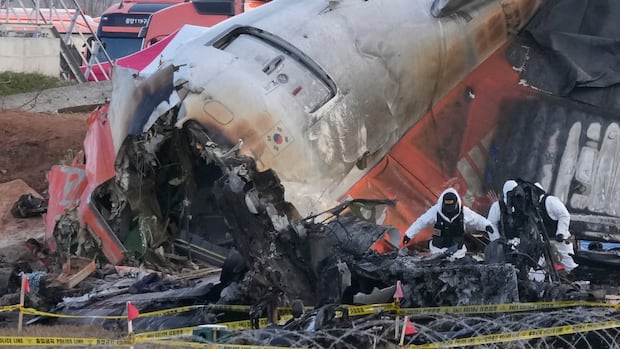The black boxes of a Boeing plane that crashed in South Korea last month stopped recording about four minutes before the accident, South Korean officials said Saturday, potentially complicating investigations into the cause of the disaster that killed 179 people .
After analyzing the devices, the U.S. National Transportation Safety Board (NTSB) concluded that both the flight data and cockpit voice recorders stopped working about four minutes before the crash, South Korea’s transportation ministry said.
The Boeing 737-800 operated by Jeju Air skidded off a runway in the South Korean city of Muan on December 29 after its landing gear failed to extend, struck a concrete structure and burst into flames, killing all but two of the 181 people Lives came on board.
After an initial analysis of the black boxes, South Korean officials sent the devices to the NTSB for closer examination when they discovered some of the data was missing. The Transportation Department said it was not immediately clear why the devices were unable to record data in the past four minutes.
“Data from the CVR (Cockpit Voice Recorder) and FDR (Flight Data Recorder) are critical to accident investigations, but such investigations are conducted by examining and analyzing various sources of information and we plan to do our best to determine the cause “investigate the accident,” the ministry said in a statement.
An investigation is underway to find out what happened after a Jeju Air Boeing 737-800 crashed off the runway in South Korea on Sunday. One of the main questions of the investigation, according to former chief engineer failure analyst Eugen Abramovici, is why the plane did not extend its landing gear during the emergency landing.
According to South Korean investigators, air traffic controllers warned the pilot of possible bird strikes two minutes before the plane sent out a distress signal confirming that a bird strike had occurred, after which the pilot attempted an emergency landing.
South Korean officials have also pledged to improve airport security after experts linked the high death toll to the location system at Muan Airport, the structure the plane hit when it crashed.
The locator, a series of antennas used to guide aircraft during landings, was housed in an earth-covered concrete structure on an elevated embankment. This has raised questions about whether the structure should have been built from lighter materials that would break more easily in an impact.
South Korea’s acting President Choi Sang-mok ordered emergency safety inspections of all Boeing 737-800 commercial airliners in the country after the Jeju Air crash killed nearly all passengers on board.



